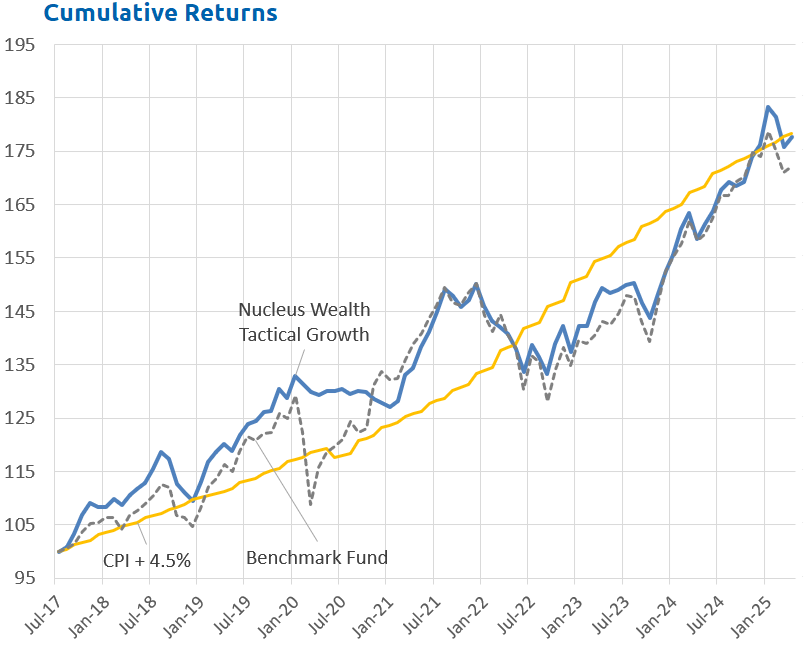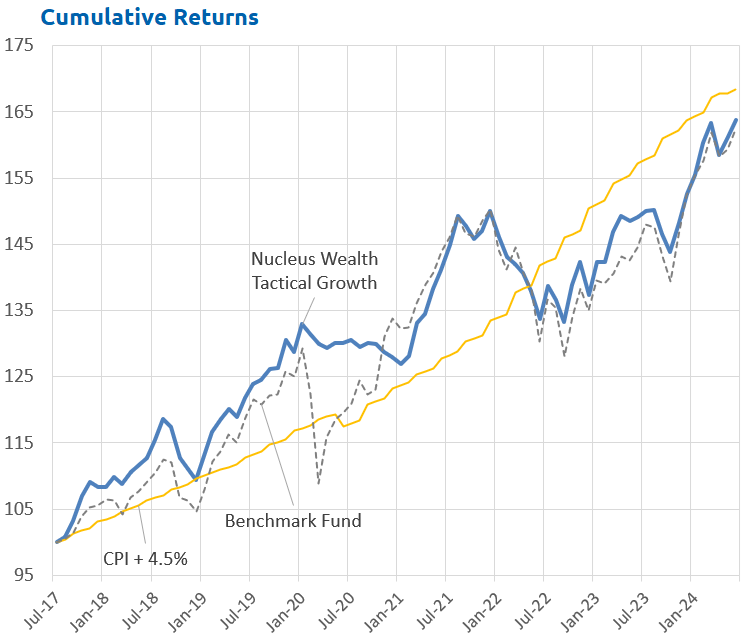June 2024 Performance
In June, the AI stocks continued to lead the charge, pushing stock markets higher. For the year to June, an almost 20% increase in international stocks drove all strategies.

This month we examine the likely effects of another Trump presidency due to its renewed prominence in the media, particularly in the context of legal challenges and policy directions. The key elements:
1. Betting Odds and Public Sentiment
Trump's odds of a political comeback are rising sharply, though they haven't caused a massive surge in polling. Unlike Ronald Reagan's significant spike after an assassination attempt, Trump remains divisive.
2. Market Reactions
Historically, Trump's rising political odds have correlated with equity market rallies and reduced volatility indexes. Inflation expectations fell, 10-year bond yields initially rose then dropped, and oil prices fell. These patterns suggest increased market volatility under a Trump administration. Trump's legal troubles add to the uncertainty.
3. Legal Dynamics
The recent Supreme Court decisions have expanded presidential immunity, potentially allowing activities that verge on bribery. Furthermore, there's a shift in power from agencies to courts, complicating regulatory enforcement. While originally intended to curb "leftist" agencies, it will likely also impact Trump's ability to make sweeping changes. This could create a "gumming up" effect, delaying significant policy implementations.
4. Potential Policies
Trump's potential second-term policies remain speculative but key indicators include tariffs and tax cuts. Tariff proposals on China could rise to 100%, intended to fund substantial corporate tax cuts from 21% to 15%. This mix of populist and supply-side economics aims to counter foreign competition while benefiting corporations. While this is likely to negatively impact Europe and emerging markets, the most severe consequences will likely fall on China. Trump's unpredictable nature makes it crucial to avoid extreme investments in specific policies or geographies as his positions could rapidly change.
Investment Strategies
Trump's fluctuating political landscape means caution with financial strategies. While equity markets may rally, the heightened volatility and potential for rapid policy reversals necessitate a balanced and vigilant approach. The evolving Supreme Court interpretations and potential tariffs and tax cuts highlight the need for investors to remain agile.
The intricate interplay of international monetary policy, tariffs, and immigration under Trump's administration can profoundly affect market dynamics and global economic stability. Particularly for the S&P 500, whose tech companies derive 60% of their revenues offshore, changes in US policy could pose serious growth challenges. For instance, a 10% appreciation in the US dollar would negate gains from domestic tax cuts for companies with significant international operations.
The bond market is also susceptible to disruptions from tariffs and inflation scares, potentially pushing up the US dollar temporarily.
The implications for global growth are concerning, especially for commodity markets. The expectation of inflation due to tariffs may not materialize; instead, deflationary or disinflationary effects could emerge, driven from a weak China economy.
The dynamics between the US and its economic policies, particularly relating to energy and trade, frequently pivot on geopolitical maneuvers. Trump's tariffs on China, for instance, were aimed at diminishing China's economic ascendency. A potential tariff war could devalue the Yuan and harm China's already struggling economy, pushing it to stimulate through property markets and potentially inducing a global economic shock.
Some specific policies to watch
Despite his populist rhetoric, Trump's policies tend to favour the wealthy and corporations. For instance, his stance on immigration includes measures like issuing green cards to international students, which may dilute the perceived benefits of reduced legal immigration for US workers. This could balloon the budget deficit and increase national debt, leaning towards disinflation rather than the inflation typically associated with corporate-oriented spending.
On a global scale, policy shifts could reposition Australia's economic activities, emphasizing the need for diversified international holdings. If the US attracts more international talent through its prestigious college system, Australia may face increased competition for skilled workers. This dynamic highlights the ripple effects of US immigration policies on global economic strategies.
Moreover, Trump's radical ideas such as abolishing the Federal Reserve introduce immense risks. Removing the Fed's ability to stabilize markets could lead to a severe economic downturn if inflationary pressures from tariffs and tax cuts spiral out of control. Historical examples like Turkey underline the catastrophic impact of undermining central bank independence.
Trade policies are another critical dimension. Massive tariffs could initially spur inflation by driving up prices for imported goods. However, this is counterbalanced by potential deflationary outcomes if demand plummets. Production might shift away from China due to reshoring activities and complex global supply chains, leading to further deflationary trends as excess production floods the market.
In essence, the anticipated short-term inflation due to tariffs and immigration policy adjustments may give way to prolonged deflationary pressures. This results from wealth concentration, reduced demand among poorer populations, and global production shifts.
If Trump secures another term and is emboldened by a coalition of radicals, could he further challenge the democratic norms? Presumably this would create significant market volatility.
Australian Impact
The Trump administration's policies had mixed outcomes for Australia, underscoring the complications of international tariffs and global trade.
Cheaper goods and reduced pressure from international students are benefits. However, China's economic strain and resulting deflationary pressures overwhelm these benefits.
Outlook
The financial and geopolitical future under administrations influenced by leaders like Trump involves significant uncertainty, with a broader range of potential outcomes.
For the next few months, and indeed continuing into a potential Trump presidency, having a portfolio which is not overly exposed to any one outcome will be important.
Asset allocation
After being very expensive for a number of years, stock markets briefly touched off average value before becoming expensive again. However, debt levels are extremely high. Earnings have been going backwards, and seem overly optimistic in 2024.
Markets are supported to a great degree by central banks and governments. Policy error is every investor's number one risk.
But, any number of other factors could force this off course and see unexpected inflation. Energy prices could jump higher, increasing inflation. Chinese/developed world tensions might rise further, leading to more tariffs. Or, China might decide again to supercharge property investment.
We are underweight Australian shares, and as noted above, overweight bonds, with the view that the Australian market is more affected by interest rates and less affected by an AI boom:

Performance Detail

Core International Performance
June was another bullish month driven almost entirely by our US stocks especially the magnificent seven. European stocks floundered as they faced election uncertainty in France and the UK. Currency proved a drag as the AUD appreciated. Over the month we trimmed out Energy exposures.
.

Core Australia Performance
Australian equities outperformed their benchmark and International stocks. Banks and growth stocks were the main drivers which was timely as we upweighted banks last month.

Portfolio Yields

This table shows the income yields of our various portfolios, including their proportion of Franking and Foreign tax paid over the past 12 months.
We also include an estimate of forecast yield (next 12 months), assuming no change in current tactical allocations and stock composition. There is an element of rising yields, as global interest rates rise. Offsetting that however, is the possibility Australian equity yields may fall as commodity-driven mining companies have lower profits to pay out. Our underweight Resource position in Core Australia portfolio should help maintain its yield.





